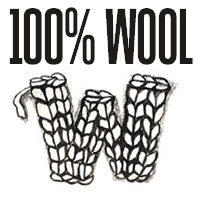We’ve not been doing an evening post generally on the weekends, but our curator for this week – Paula Wolton of One Hut Full – provided such an abundance of material that we have a bonus post for you tonight! Tonight we hear from Jane Brady, who is a co-founder of The Bioregional Learning Centre in South Devon. We have had many voices on the Wovember blog this year who bring a woolly perspective from the crafts sector; it speaks to Paula’s fantastically joined-up approach to Woolness & The Land that she has found someone to share a perspective from elsewhere in the web of which wool and land are both a part.
Professionally, I take “woolness” seriously. Here in South Devon, wool has the potential to be a very important part of a thriving “fibreshed”. Think of a fibreshed like a watershed (an area of land that drains collected water to a common outlet, bringing benefit to those who live there). It’s a regional fibre system of producers and supporters who share a common goal; to revive the role of fibre (wool, flax, hemp and nettles, for example), build the soil and create community. Fibershed in California have articulated and promoted this concept really well (with offshoots taking root in the UK).
Noticing the “sheds” in a landscape — fibre, water, energy, food and waste — is the first step in seeing what’s around you in a different way; as an organically-formed and interconnected system based on natural resources and economic activity that are unique to a particular place. Honouring that system validates traditional livelihoods and gives rise to innovative ones, especially when combined with influences from elsewhere. That’s where wellness comes in: a local economy regenerating itself, with citizens working together in practical and imaginative ways to look after their natural assets and rethink ways to keep us warm, clothed, fed and fulfilled.
Personally, “woolness” brings to mind my friends. Martha, in Portland, Oregon, grew up with older parents, like mine, who mended and made do. Her face lights up at the feel of a second-hand wool jumper in a thrift store as she imagines its coziness over many years to come.

Katja, my Swedish friend toughing it out in Italy, questions the adjective “woolly” – vague, fuzzy, inexact, confused, muddled, disorganized. In Swedish, “helylle” (homegrown, woolly) means reliable, splendid… in a durable and inspiring way. Perhaps someone accused of having woolly thinking simply has different values? But, she adds, “it can also mean a bit cuckoo in the head”.
Maybe woolness is a bit cuckoo, but it makes perfect sense to me.
Jane Brady is a co-founder of The Bioregional Learning Centre whose aims are to drive whole-systems change for a sustainable future, to engage both citizens and policy-makers in this and to share the learning that emerges. All content © Jane Brady and used with kind permission. We love how this post gives a bioregional perspective on wool. Thank you Jane and Paula for this last installment of Woolness & The Land.
